Electrostatic precipitators are used in many industries for the high efficiency of collection particulate matter.They were developed in the early 1900s. During the 1940s, precipitators began to be used for particulate matter control at cement industries, iron and steel industries, coal fired boilers, etc.
Many means of cleaning the industrial exhaust gases are utilized such as cyclones, bag filters, scrubbers etc, but the most efficient and effective solution is to use of electrostatic precipitators which may be designed for efficiencies up to 99.96%.
Particals down to 0.01 microns are collected which are too small to filter by other means.
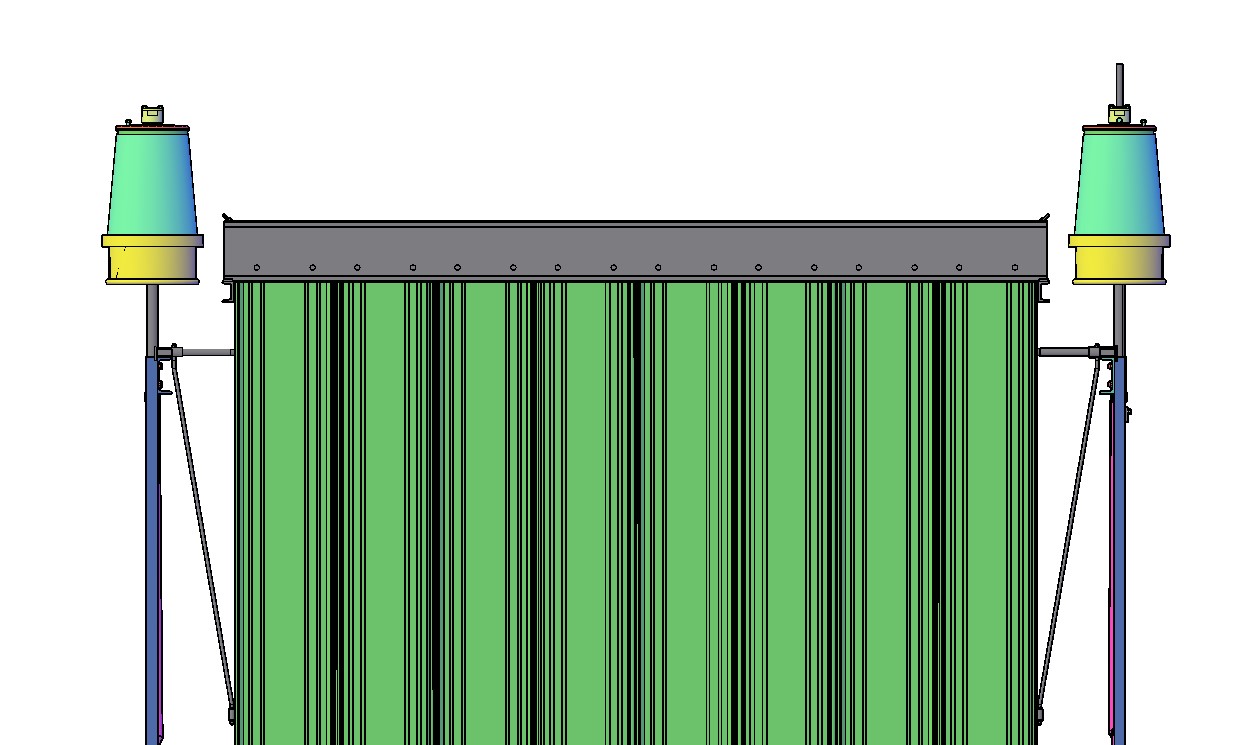
There are 3 main steps to particulate dust collection :
• Step 1 : electrical charging and migration of particles toward a collecting surface
• Step 2 : rapping collected dust from the collecting surface to hoppers
• Step 3 : removed accumulated dust from hoppers to a storage area.
As the precipitator is turned on, electrical charging starts and an electrical field is formed between discharge and collecting electrodes. Increasing the precipitator voltage a level is reached where electrodes start escaping from the sharp points of the discharge electrodes and migration occurs, a phenomenon named Corona-Effect. Discharge electrode carry negative DC voltage between 30-145 kV depending on design and application.
The negative gas ions produced, charge the dust particles with negative charge. These particules migrate toward the positive collective plates where they release their charge.
When the ESP energize with high transformer rectifiers, automatic voltage controller in the control cabinet apply maximum possible voltage to the ESP.
There are six main factors limits the maximum secondary voltage :
• Primary voltage limit
• Primary current limit
• Secondary voltage limit
• Secondary current limit
• Spark rate limit
• SCR conduction angle

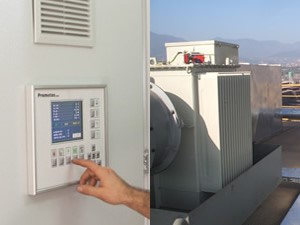
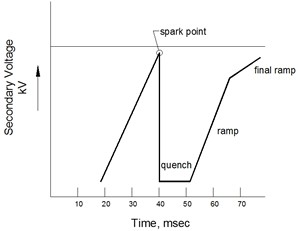
The primary voltage, primary current, secondary voltage and secondary current can be setted by the operators at levels necessary to protect T-R set components. The automatic voltage controller controlls these values to protect electrical circuitry.
Most of the new installations have screen pannels to show the operating limit and all other usefull parameters. These values are very useful for evaluating precipitator performance.
If there is not any spark in a field, the electrical conditions in the field will remain very stable until dust loadings or other changes affect the electrical conditions. If electrical sparking occurs, there will be short-therm variations in these indicated operating conditions. After each spark in a precipitator field, the automatic voltage controller shuts off the primary voltage for a short period of time (miliseconds) to prevent the short-therm spark from becoming a sustained, damaging power arc. Once this quench period is over, the voltage is ramped up quickly to a voltage very close to the previous point at which the spark occured. The voltage then gradually increased to the point where another spark occurs.
After the particals have attached ions, they are influenced by the strong electrical field between the discharge electrode and grounded collecting plate. Accordingly, the charged particals begin to migrate toward the grounded collecting plates at a velocity called migration velocity. At the same time, drag forces, which depend on the particle mass or particle diameter, are trying to move the particles straight through the precipitator. As a result, smaller sized particals are deposited near the inlet and progressively larger particles are deposited farther into the precipitator.
Migration velocity is a very important parameter for the efficiency of electrostatic precipitators. High migration velocity is prefered for high efficiency of precipitators.
For high precipitator performance, migration velocity must be highest level. It means that charge on particle (q) and electric field (E) must be highest level. It is claer that when an electristatic precipitator has a high secondary voltage (kV) and secondary current (mA) the efficiency will be highest level.
Particle size is another importrant parameters for electristatic precipitator efficiency.
There are very high collection efficiencies above 1.0 µm. But between 0.1 to 1.0 µm, there is a difficulty. The precipitator is least effective for the particle in this range.

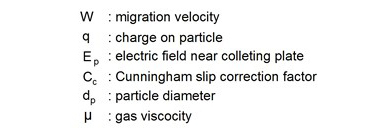
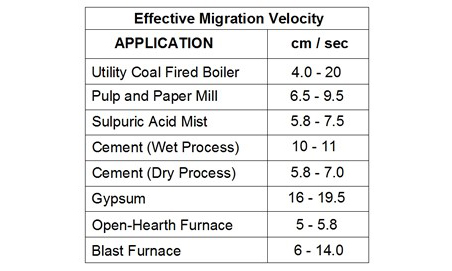
Resistivity is a measure of a particle's resistance to transferring electricle charge. It is a caracteristic of particles. Resistivity is a function of a particle's chemical composition as well as flue gas operating conditions such as temperature and moisture.
Particles have high, normal or low resistivity. Resistivity is an important factor for precipitator efficiency. With the high level resistivity, it is difficult to charge the particles. And if they charged once they do not give up their charge on arrival at the collecting plates. On the other hand, with the low level resistivity, the particles easily become charged and quickly release their charge to the grounded collection plates. Both extreme resistivities effect precipitator's functioning negatively. Electrostatic precipitators work best under normal resistivity.
Low Resistivity : between 104 and 107ohm.cm
Normal Resistivity : between 107 and 1010 ohm.cm
High Resistivity : above 1010ohm.cm
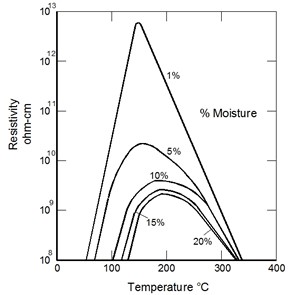
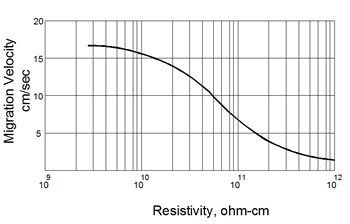
During the operation, metal surface of collecting plates are electrically grounded and the voltage is zero. Whereas the outer surface of the dust layer on the collecting plates, where new particles and ions are arriving, the voltage can be quite high. The strength of this electrical field depends on the resistivity and thickness of the dust layer. When the resistivity of dust layer is high, the dust would not be enough conductive and therefore electrical charges have difficulty moving through the dust layer. There is a strong electric field. Electrical field depends on the resistivity and thickness of dust layer. Particles are held strongly to the collecting plate. This dust layer can not be removed easily and there would be a rapping problem.

In low resistivity, corona current is easily passed to the collecting plates. Because of the weak electric field on the dust layer, collected particles with low resistivity do not adhere strongly. They are easily join again to the gas stream.
Electrostatic precipitators work best under normal resistivity conditions. Particles do not lose their charge on arrival at the collecting plates. These particles leak their charge slowely to collecting plates. Therefore the particles are held on the collecting plates and removed from the collecting plates by rapping.
There are 3 main adverse effects can occur when the resistivity is high. First, the voltage between discharge electrode and collecting plate reduces. Electrostatic field strength reduces. Therefore the migration velocities of small particles are especially effected (reduce) and the efficiency of the precipitator reduces.
The secondly, back corona occurs when the resistivity is high and dust layer thickness is so great. There are micro-discharges between the particles from dust layer on the collecting plates. The dust layer breaks down electrically and back corona discharge occurs. After back corona discharge, small holes and craters occur on the dust layer and the reoson of this back corona discharge, positive gas ions generated within the dust layer and these ions accelerated toward the discharge electrodes. This positive gas ions neutralize some of the negative ions heading toward the collecting electrode.This phenomenon (back corona) reduce the efficiency of normal corona process. It means that the efficiency of electrostatic precipitator reduce appr 50%.
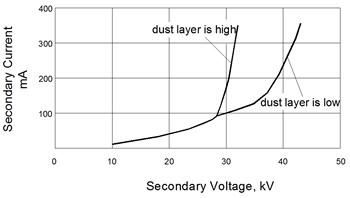
The third and common problem is electrical sparking. With high resistivity, sparks are increased. When the spark rate is high (commonly more that 30-35 sparks/min) the automatic controllers limit the secondary voltage on the field. This reduce particle charging (normal corona) and reduce migration velocity towards the collecting plate. At the end, efficiency of precipitators drop down dramaticaly.
High resistivity can be reduced by;
• Adjusting the temperature,
• Increasing moisture,
• Adding conditioning agents,
• Increasing collecting surface area.



